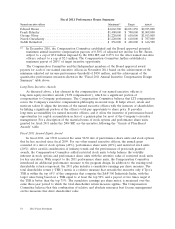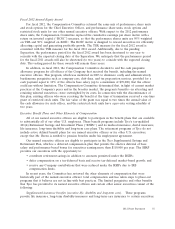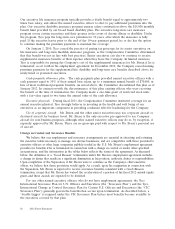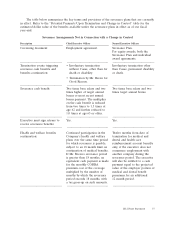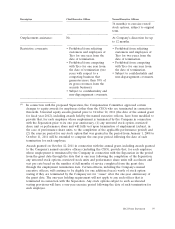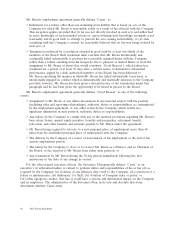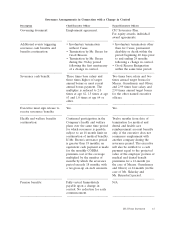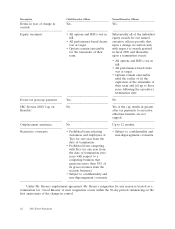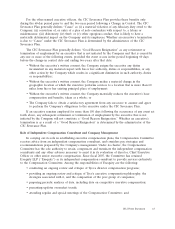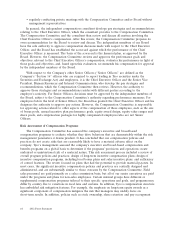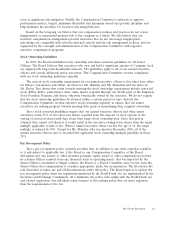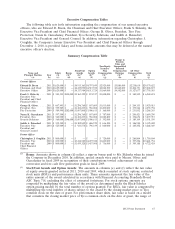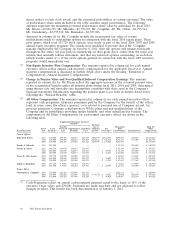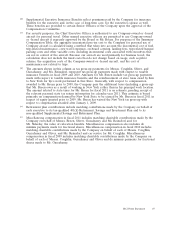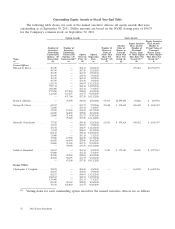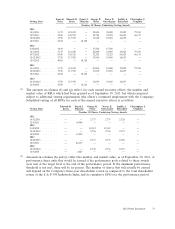ADT 2011 Annual Report Download - page 78
Download and view the complete annual report
Please find page 78 of the 2011 ADT annual report below. You can navigate through the pages in the report by either clicking on the pages listed below, or by using the keyword search tool below to find specific information within the annual report.•regularly conducting private meetings with the Compensation Committee and/or Board without
management representatives.
In general, the independent compensation consultant develops pay strategies and recommendations
relating to the Chief Executive Officer, which the consultant provides to the Compensation Committee.
The Compensation Committee and the consultant then review and discuss all matters involving the
Chief Executive Officer’s compensation. After this review, the Compensation Committee prepares its
own recommendation for the Board to review and discuss. The independent members of our Board
have the sole authority to approve compensation decisions made with respect to the Chief Executive
Officer, and the Board has established the scorecard against which the performance of the Chief
Executive Officer is measured. The basis of the scorecard is the financial plan, as approved by the
Board. However, the Compensation Committee reviews and approves the performance goals and
objectives relevant to the Chief Executive Officer’s compensation, evaluates his performance in light of
those goals and objectives, and, based upon this evaluation, recommends his compensation for approval
by the independent members of the Board.
With respect to the Company’s other Senior Officers (‘‘Senior Officers’’ are defined as the
Company’s ‘‘Section 16’’ officers who are required to report trading in Tyco securities under the
Securities and Exchange Act) and employees, it is the Chief Executive Officer and the Senior Vice
President, Human Resources and Internal Communications, who develop the pay strategies and
recommendations, which the Compensation Committee then reviews. However, the authority to
approve those strategies and recommendations resides with different parties according to the
employee’s seniority. For Senior Officers, decisions must be approved by the independent members of
the Board, subject to the Compensation Committee’s authority regarding performance measures. For
employees below the level of Senior Officer, the Board has granted the Chief Executive Officer and his
designees the authority to approve pay actions. However, the Compensation Committee is responsible
for approving actions related to other aspects of the compensation of these employees, such as the size
of bonus pools, annual incentive plan performance goals, equity award design, equity value ranges and
share pools, and compensation packages for highly compensated employees who are not Senior
Officers.
Risk Assessment of Compensation Programs
The Compensation Committee has assessed the company’s executive and broad-based
compensation programs to evaluate whether they drive behaviors that are demonstrably within the risk
management parameters it deems prudent. It has concluded that our compensation policies and
practices do not create risks that are reasonably likely to have a material adverse effect on the
company. Tyco’s management assessed the company’s executive and broad-based compensation and
benefits programs on a global basis to determine if the programs’ provisions and operations create
undesired or unintentional risk of a material nature. This risk assessment process included a review of
overall program policies and practices; design of long-term incentive compensation plans; design of
incentive compensation programs, including local bonus plans and sales incentive plans; and sufficiency
of control features. The review focused on plans that had the potential to provide material payouts. In
most cases, the significant incentive compensation policies and practices are centrally designed and
administered, and are substantially similar to those overseen by the Compensation Committee. Field
sales personnel are paid primarily on a sales commission basis, but all of our senior executives are paid
under the programs and plans for non-sales employees. Certain internal groups have different or
supplemental compensation programs tailored to their specific operations and goals, and programs may
differ by country due to variations in local laws and customs. In addition, Tyco’s compensation structure
has embedded risk mitigation features. For example, the emphasis on long-term equity awards as a
significant component of compensation mitigates the risk that managers may unduly focus on
short-term results. In addition, policies such as stock ownership, share retention and pay recoupment
64 2012 Proxy Statement


